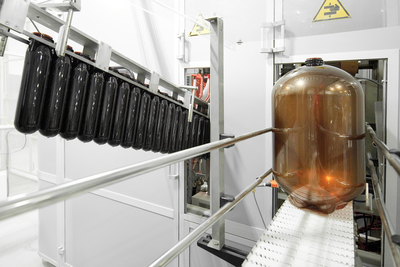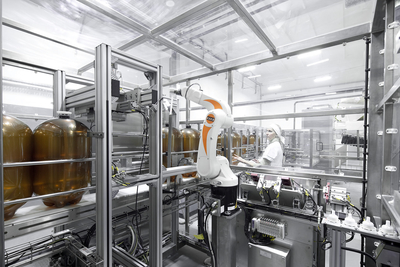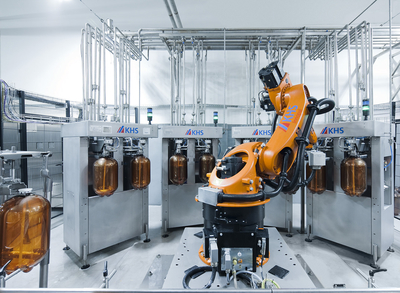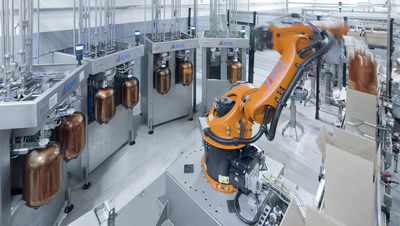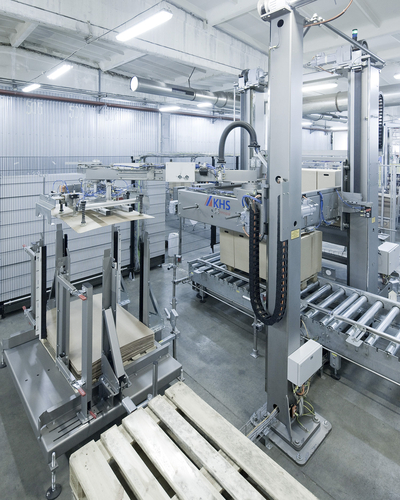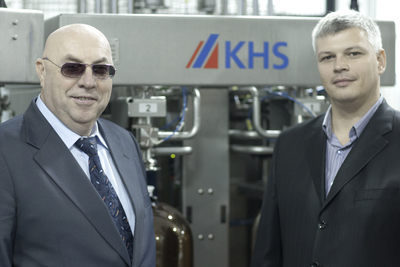
A Pioneering Performance
Lipetskpivo in Central Russia is the first brewery worldwide to invest in a fully automatic KHS Petainer keg line
Dr. Felix Wagner* Jörg Lauer** Alexander Burenin*** The city of Lipetsk in Central Russia boasts a brewery which is rather different to its competitors in the brewing sector – and because of this has reaped a fair amount of success on the market. The Lipetskpivo Brewery, founded in 1977, used to be state owned. In 1992 it was turned into a corporation. In 2002 Vyacheslav Markov took the helm as the brewery's managing director which proved to be a decisive step, for since then the brewery has been continuously extended and modernized. In 2002, for example, Lipetskpivo produced around 160,000 hectoliters of beer, soft drinks, fruit juices, and water; by 2011 the output had rocketed to about one million hectoliters. When asked about his personal recipe for success, Markov replied, "We gear our enterprise towards what consumers want." It's this extreme loyalty to consumer demand – among other things – which has recently made the company a pioneer among the breweries of the world. Lipetskpivo is the first brewery worldwide to invest in a fully automatic KHS Petainer keg line. "We'd been looking for a concept like this for some time", states Markov, "partly because we wanted to save our clients and ourselves from having to return kegs, and also to make keg handling easier. When we heard about KHS' Petainer keg system, we were all for it. We immediately arranged a meeting with the experts from KHS and realized that this concept has exactly what we've been after for a long time. There was no longer any question about it; we very quickly ordered the Petainer keg line designed by KHS. In retrospect, this was absolutely the right decision to make." * Manager, Filling and Keg Technology Competence Center, KHS GmbH, Kriftel, Germany. Phone: +49 (6192) 491-125 ** Petainer Keg Project Manager, KHS GmbH, Kriftel, Germany.Phone: +49 (6192) 491-206 *** Sales, KHS Russia. Phone: +7 (495) 783-8100 From the region and for the region Lipetskpivo sees itself as a brewery from the region and for the region, its distribution radius being around 500 kilometers from its own doorstep. Lipetskpivo holds second place in the brewery ranking for this area, with BBH holding the top spot. The brewery in Lipetsk supplies both retailers and the hospitality trade with beer and non-alcoholic beverages, which – and this is a decisive factor, according to Markov – the average Russian employee can afford, the mean monthly wage being around € 550 or 22,500 rubles. Lipetskpivo firmly adheres to its concept of providing consumers with a quality product at a fair price. A 1.5-liter PET bottle of Lipetskoe or Priyatel beer, for instance, the two brands produced at Lipetskpivo, can be purchased at a retail store for about 90 rubles. As statistics and other sources prove, beer consumption is both high and enjoyable at such prices, with the annual per capita consumption of beer in the Lipetsk region at approximately 70 liters. Flexible production of various beer and beverage brands Today, 68% of Lipetskpivo's sales are attributable to the brewery's two aforementioned beer brands. Soft drinks and fruit juices account for a further 14.5%, with water clocking up 13% of the total sales and kvass 4.5%. Markov believes that these figures will and may shift in relation to one another in the near future. "With our technical setup we're now prepared for all eventualities and in the future will continue to produce entirely in keeping with customer demand," Markov claims. "If more water, soft drinks, fruit juices, or kvass and less beer are required, we'll simply change our production scheme. This means we're always able to serve the market to maximum effect." The right container Best serving the market also means supplying the product in the right container, thinks Markov. This means using containers that the target group of people on an average wage can afford. Filling beverages in cans and glass bottles is thus out of the question. The non-refillable PET bottle therefore has the top slot in the range of possible containers. The 1.5-liter PET bottle is particularly popular, with about 50% of total production dedicated to this receptacle. Another type of choice packaging, especially for Lipetskpivo's brand beers, are the 30-liter and 50-liter keg varieties. To date 12% of the brewery's filling volume has been fed into the classic refillable steel keg. The biggest disadvantage of such kegs, in the eyes of Lipetskpivo, is the amount of economic effort they cause. Costs for return, storage, and washing play a decisive role here. Lipetskpivo thus asked itself whether a non-returnable PET keg system would be feasible and whether it would help to avoid such expense. ‑{}‑ The Petainer keg – the long-awaited keg variant "When we first heard about the Petainer keg," says Markov, "we realized that this was just the type of keg we'd been waiting for. It seemed almost too good to be true to discover that KHS had already worked out a processing system for the Petainer. In various talks we grew more and more positive about the Petainer keg and thus decided to become pioneers and invest in the first fully automatic, KHS turnkey Petainer keg line worldwide. In doing so we're emphasizing our belief that you can only get a real edge on the market when you act on said market as a pioneer". Many economical and ecological benefits Petainer kegs are non-refillable, disposable kegs that do not have to be returned to the brewery and which are 100% recyclable. As opposed to the classic refillable steel keg, this saves not only on logistics for keg return to the brewery but also on outgoings for keg washing. It is also no longer necessary to have a fleet of kegs on hand; Petainer kegs can be ordered entirely according to local market demand or even manufactured inline on a special Petainer keg line. Where the KHS Petainer keg system is used, storage costs are considerably reduced – and costs for keg repairs become a thing of the past. Petainer kegs in sizes of 15, 20, 30, and 40 liters are currently available and come with a compatible flat fitting and a basket fitting. One 40-foot standard container can deliver 40,000 fittings sets and preforms. Lightweight container makes logistics and handling easier Another advantage of the Petainer keg which has a positive effect on both transportation and handling at the customer's site is its light weight. Petainer kegs that hold 15 or 20 liters weigh just 250 grams, with 30 liter Petainer kegs slightly over the 400-gram mark. By way of contrast, steel kegs of these dimensions notch up between six and seven kilograms on the scales. This means that when transporting racked Petainer kegs the overall weight of the truck is much lower compared to one loaded with racked steel kegs – and that more kegs can be delivered per truckload. It's been calculated that logistics costs for deliveries of Petainer kegs are reduced by between around 20% and 30% per hectoliter of beer. This, plus the fact that there is no need to return Petainer kegs (as mentioned above), means that the Petainer is a particularly sustainable system. In addition, the low individual weight of full Petainer kegs as opposed to steel kegs makes them easier for retailers and restaurateurs to handle and attach to the tapping equipment. What's more, as Petainer keg fittings are fully compatible with standard tapping apparatus, Petainer kegs can be connected up to existing systems for draught beer just like classic steel kegs. The bar staff don't even have to be retrained! Easy to recycle After being relieved of pressure, empty Petainer kegs can be easily folded and disposed of as recyclable waste. "We find it extremely positive that Petainer kegs look very individual but are instantly recognizable as being thin-walled containers," says Markov. "This means that they are also associated with the need for more careful handling than with classic steel kegs." Best product quality ensured Another decisive and positive aspect is that the Petainer keg gives clients top product safety thanks to the use of modern barrier technology. Scavenger material integrated into the PET specifically prevents oxygen from penetrating the container. Nylon particles protect the product from CO2 loss. Pigments in the polymer also help to guard the contents against infiltration of UV light. The minimum shelf life of beer racked in a Petainer is thus nine months – with the quality of Petainer-racked beer comparable to beer in steel kegs in every possible way. Various Petainer keg processing options When a customer decides to invest in a technical system that processes Petainer kegs, KHS has various options on offer. For those who first wish to test the market acceptance of Petainer kegs by producing small quantities, the USD keg by Petainer, first presented at Brau Beviale 2011, and the Petainer adapter supplied by KHS are viable alternatives. Both can be put to use in classic KHS keg lines. The stability of the Petainer keg during racking is ensured. If beer is to be racked at a rate of up to 60 Petainer kegs an hour, KHS' semiautomatic Innokeg Till PETBoy F2 Petainer keg racking system could prove a prudent investment. Lipetskpivo, however, thinks big – and for good reason. "We're convinced of the success of the Petainer keg," enthuses Markov, "and are reckoning on a substantial demand from our customers. We therefore decided to invest in a fully automatic, KHS Innokeg Till PETLine F8 Petainer keg system which can cater for the expected market demand." Lipetskpivo acquires a fully automatic Petainer keg line with a capacity of 240 Petainer kegs an hour The output of this fully automatic Innokeg Till PETLine is 240 Petainer kegs an hour. At present the line is set up to rack 30-liter Petainer kegs only. Markov comments, "In our view the 30-liter Petainer keg best combines all the economical and ecological advantages. Our current plan is to limit ourselves to processing this size of Petainer keg. However, it's good to know that should we make any changes at our end, our KHS system can be adapted to fit." Inline production of Petainer kegs So that it has maximum flexibility regarding the number of Petainer kegs that have to be provided, Lipetskpivo manufactures its containers inline. The preforms and fittings are supplied by the manufacturer. The preforms are blown in a blow molder which has an automatic preform intake. Once the Petainer kegs have been blown, they are sent off to the fitting inserter on a conveyor enclosed in Plexiglas for ultra hygienic transportation. Here, a handling robot first grips the fitting and attaches it to the riser pipe. This robot then inserts the assembled elements into the Petainer keg. Innokeg Till PET Boy F 2 combined with cutting-edge robot technology The kegs then travel to a filling and packaging area specially tailored to Lipetskpivo's specific requirements, where four Innokeg Till PETBoy F2 racking segments, each with two Petainer keg racking stations, are arranged in a semicircle. The eight racking heads are fed with Petainer kegs by a robot which has a radius of action of 240°. The robot has a swivelable gripper head which can transport two Petainer kegs at once. The robot first picks up the empty kegs that have been fed into the system and positions them under the individual racking stations. Once the first Petainer keg has been racked, the robot takes an empty Petainer keg from the conveying segment and travels with it to the racking station where the full Petainer keg is awaiting removal. It then picks up the racked keg, swivels its gripper head, and places the empty Petainer keg in the vacated racking station. This process is repeated after each further Petainer keg has been racked. The robot then places the racked Petainer keg in a packaging carton which is positioned within the robot's reach by a carton erector. When packed with one Petainer keg apiece the cartons then travel on to the carton sealer and carton coder. If the robot receives a signal that the racking process for a Petainer keg has not gone according to plan, this container can be rejected. The robot takes the incorrectly racked Petainer keg to a chute which removes said keg from the system. Extremely low-oxygen racking process with precise racking levels Petainer kegs are racked in the Innokeg Till PETBoy F2 as follows. The Petainer keg is connected to the racking head. The first step is to test the pressure to ensure that the Petainer keg does not leak. If a keg fails this pressure test, it is removed from the process chain. 'Good' Petainer kegs then have their fittings washed with water, ensuring that any residual dust or dirt is reliably removed. After the fitting has been opened, the next step is to purge the Petainer keg of air with CO2. This replaces air with CO2 and thus more or less completely removes all oxygen. The keg is then pressurized with CO2. The racking process starts with a slow initial racking phase, followed by a fast racking phase and a concluding slow racking phase. This ends only when the Petainer keg contains the given volume of liquid measured by electromagnetic inductive flowmetering. Racking by means of electromagnetic inductive flowmetering ensures exact filling levels. Overfilling is not necessary; product is thus saved. If the Petainer keg has been racked according to specification, the fitting is closed and the Petainer keg has a final rinse to remove any beer residues before it leaves the racking area. KHS' turnkey concept also includes an Innopro pasteurizer and Innopro CIP system. Perfect carton sealing An Innopack CV carton sealer downstream of the racking and packaging process ensures flawless glue application and perfectly sealed cartons. The central drive of the side conveying belts ensures that the belt motions are synchronous, and the gluing process is performed with the utmost precision. Before the cartons are sealed, they are coded, and their weights are checked by a check weigher equipped with an automatic faulty carton rejection feature. After the carton sealer and before they are conveyed to the palletizing station, the cartons pass through a carton labeler. Reliable palletizing An Innopal PBL1N1 column-type robot, equipped with a low pack infeed, is responsible for palletizing the cartons. These cartons are first positioned by the robot as programmed. Pack manipulation elements, such as turning stations or gap splitters, are no longer needed. In addition to the resulting cost benefits, this has the additional advantage of gentle pack handling. A handling robot inserts pallet liners. A stretch film wrapping machine secures the pallet loads. Beverage industry showing great interest worldwide Roman Lizunov, manager of the engineering department at Lipetskpivo, is pleased with the results. "Our KHS Petainer keg line just keeps on running. We're extremely satisfied. Moreover, the line is also a visual attraction and our employees like to work on it." Markov adds, "As a pioneer the beverage industry worldwide is showing plenty of interest in our new plant engineering from KHS. We've already had lots of visits from national and international beverage companies." Future success planned According to Markov, Lipetskpivo will only really start marketing the Petainer keg next spring. By then all test phases in the hospitality and food trade will have ended and marketing concepts developed. First response from the market has, however, been extremely encouraging. As expected, the light weight and easy handling of the Petainer keg have proved convincing in various restaurants, cafés, and bars. Food retail customers enjoy tapping their own 'fresh' beer at home from the Petainer keg. "The experience we've had so far with the Petainer keg allows us to believe it will continue to be successful," states Markov. "By next summer at the latest we're reckoning on our KHS Petainer keg line running in two shifts at full capacity." If Lipetskpivo's forecast is right, the Petainer keg will do much to further Lipetskpivo's success. And in the future the brewery also plans to rack soft drinks in Petainer kegs beside beer and kvass. Production capacity of 2.5 million hectoliters by 2013 The brewery is planning on continuing its strategy of growth and quality. They will continue to modernize the plant and extend their production capacities up until the end of 2013, the latter enabling a yearly beverage production of up to 2.5 million hectoliters. KHS not only supports this growth as a reliable partner for turnkey systems and the servicing thereof; in cooperation with the Petainer company it is also a supplier of modern one-way keg systems. KHS is the only sales partner for Petainer keg products worldwide. Markov concludes, "We also assume that our output will have reached 2.5 million hectoliters by 2013 as our concept of 'From the region and for the region' is being excellently received by consumers." Lizunov adds, "It's being well received because the quality's right. With top-quality technical machinery such as our new KHS Petainer keg line, from a point of view of quality we're definitely on top of things. And will stay that way in the future." And that just about says it all.

